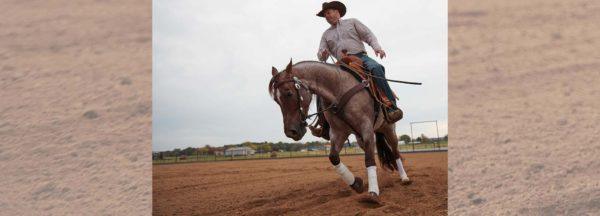Training Tip: A Horse’s Age is Just a Number

When someone tells me how old a horse is, I never make a correlation between the horse’s age and how well-trained and experienced he is. Nothing will get you into trouble faster than making an assumption about a horse’s training based on his age.
The horse industry as a whole generally lumps all young horses that have been started under saddle into a group called “green-broke” and tends to classify any horse over the age of 10 as broke. When I use the term green-broke, I’m talking about a horse that is relatively inexperienced. He can walk, trot and canter and you have some basic control of his body, but you can’t do a whole lot with him. A perfect example of what I’d call a green-broke horse is the level of training the colts are at by the end of one of our 10-day Colt Starting Clinics. Participants can walk, trot and canter their horses confidently in the arena and on the trail and steer them and stop them, but that’s about as fancy as it gets. I’d classify a horse as broke when he’s been through the Fundamentals, Intermediate and Advanced levels of the Method. He is calm, respectful, soft and willing and you can control each of his five body parts effortlessly.
While it might seem like it would be a safe bet to assume that a 3-year-old horse was green-broke and a 15-year-old horse was a well-trained, broke mount, it’s not. I would agree that the majority of people’s young horses are not very broke—they’re spooky, jumpy and unreliable. But the reason I don’t assume that all 2- or 3-year-old horses are green is because I’ve seen some very well-trained 2- and 3-year-old horses. We work with our 2-year-olds on the ranch for an hour and half, six days a week. They get ridden in the arena and on the trail and worked on obstacles. After six months of being ridden in a consistent training program like that, those colts ride better than most people’s 10-, 12- or 15-year-old horses!
I think a lot of people get tricked by this concept when they first enter the horse industry. They’re out looking for a horse and they assume that the 10-year-old gelding has to be a safer, more reliable mount for them than the 3-year-old horse. Instead of relying on a horse’s age to clue you in on his training and level of experience, I’d like you to ask three questions: How many hours has the horse been ridden? How many miles has he been loped? How many hours has he been ridden away from home?
Those three numbers tell you a lot about a horse’s experience and the training he’s received. The total hours he’s been ridden let you know how much experience he’s had under saddle. While there’s no guarantee about what sort of training he’s had, the hours clue you in to how much he’s been ridden in his life. Just as kids don’t get educated sitting in front of the TV, horses don’t get trained standing in a stall or pasture. Before you buy a horse, it’s important to know how much training he’s had. My mentor Gordon McKinlay told me that a truly great, well-broke horse needs three equal doses of long rides, wet saddle pads and concentrated training. The only way to put long rides, wet saddle pads and concentrated training on a horse in three equal doses is to put some steady miles under his feet.
The second number, how many hours he’s been loped, is just as important. I don’t care what anybody says, you can’t get a mature, steady, level-headed horse without putting some loping miles under his feet. I know from experience that only walking and trotting a horse is like trying to bake a cake without using flour: it just doesn’t work. Loping turns young horses into old horses, and it’s something that doesn’t happen at the walk.
The third number, how often the horse has been ridden away from home or out of the arena, clues you in about how comfortable the horse is being ridden outside of the arena. I know plenty of reining horses that have been ridden for thousands of hours, but they’ve only been ridden in the arena. If you’d take them out on a trail, they’d half kill you. In my opinion, a well-broke horse should safely carry a 90-year-old grandma down the trail.
Have a horsemanship question or looking for more training tips? Check out the No Worries Club.
